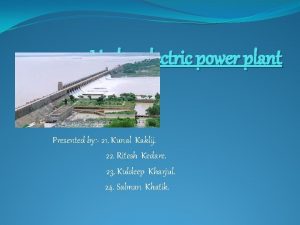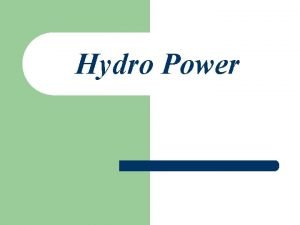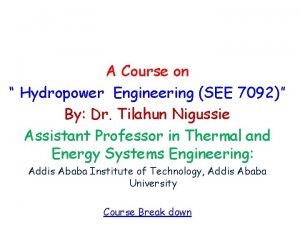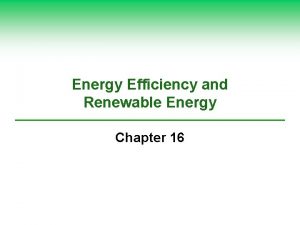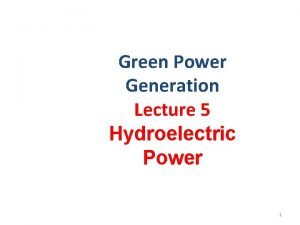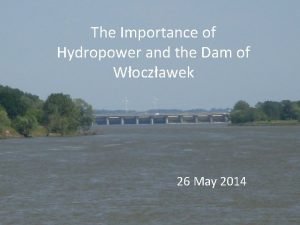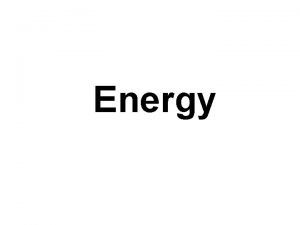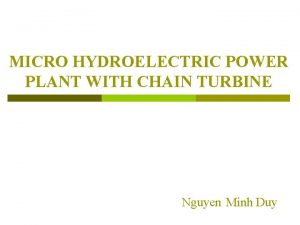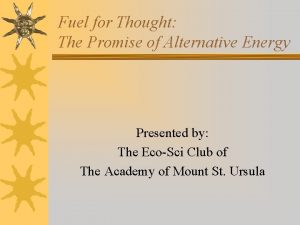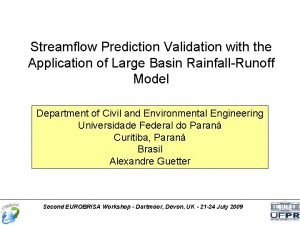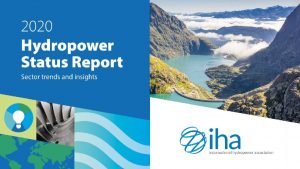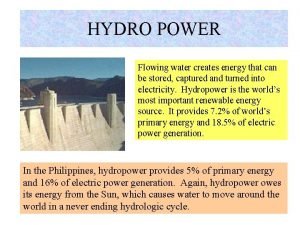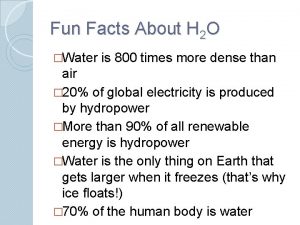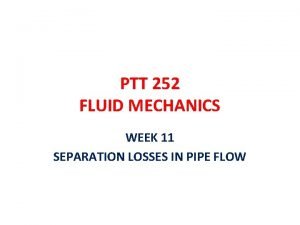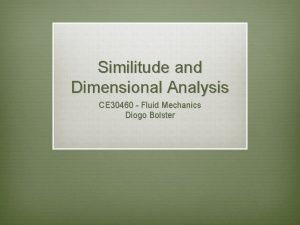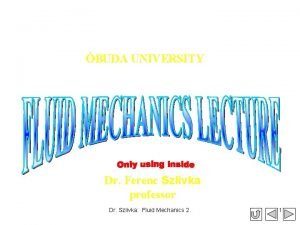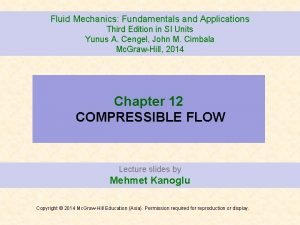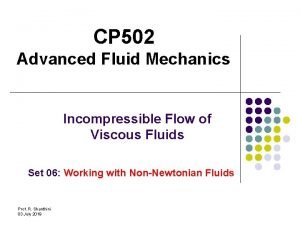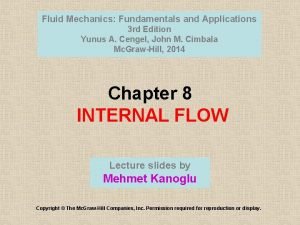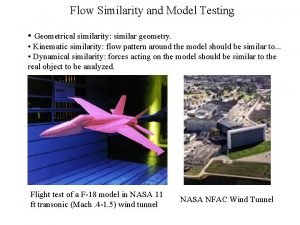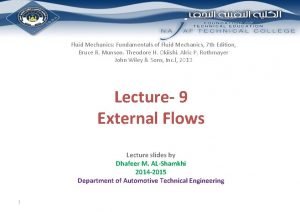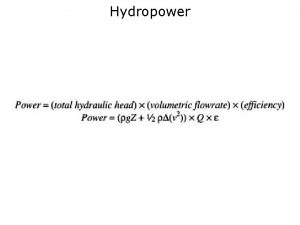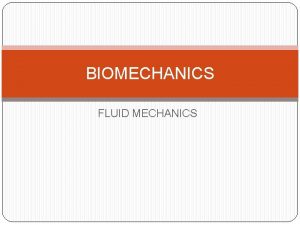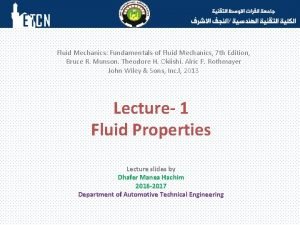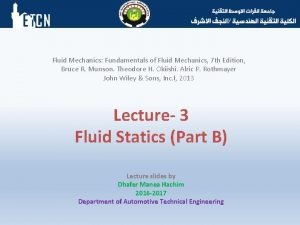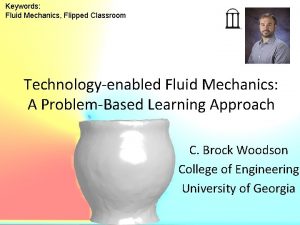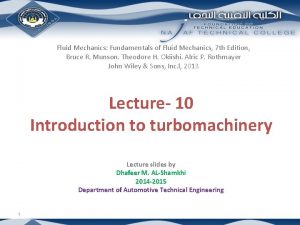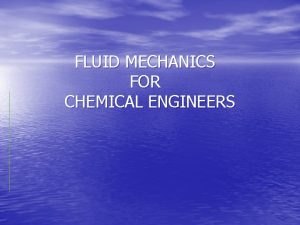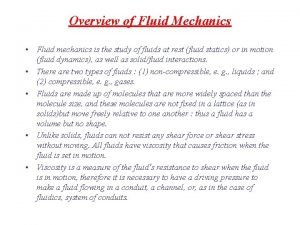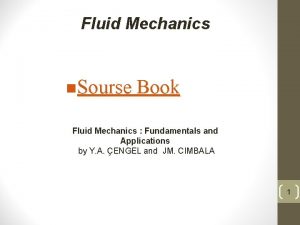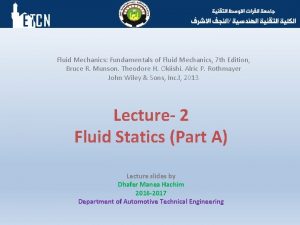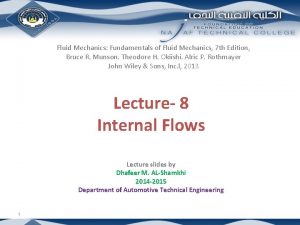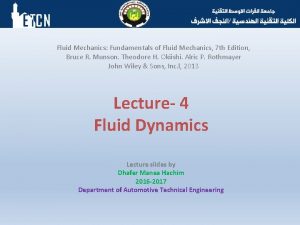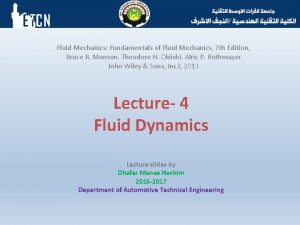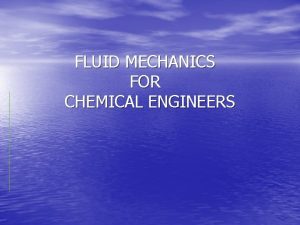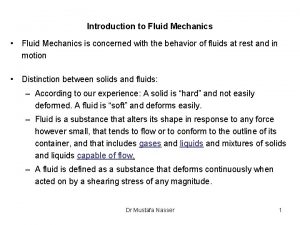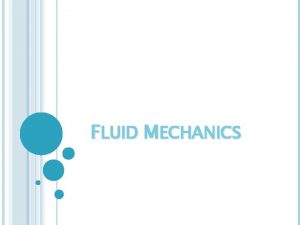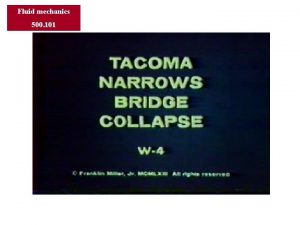Environmental Fluid Mechanics Hydropower Plants a y 201213





























- Slides: 29

Environmental Fluid Mechanics – Hydropower Plants (a. y. 2012/13, 9 credits – 90 hours) Transport processes and impacts Marco Toffolon e-mail: marco. toffolon@ing. unitn. it Laboratorio Didattico di Modellistica Idrodinamica (2 nd floor, central corridor) tel. : 0461 28 2480 Hydrology and water resources Constructions e-mail: alberto. bellin@ing. unitn. it e-mail: maurizio. righetti@ing. unitn. it prof. Alberto Bellin prof. Maurizio Righetti

Part II: Transport processes in the environment II-1. Introduction (10 hours) Basic concepts: definition of concentration, mass balance, diffusion. Turbulent mixing. Gaussian model for diffusion processes: basic solution and typical scales. Advection-diffusion equation and analytical solutions in the one-dimensional context. Phases of mixing: near field, intermediate field, far field. Dispersion resulting from non-uniform advection. Dynamics of reactive tracers (including temperature): zero- and one-dimensional models. II-2. Transport processes in rivers and effects of hydropower production (9 hours) Review of basic hydraulic concepts. Estimates of turbulent diffusion and dispersion coefficients. Flood waves due to sudden releases from hydropower plants (hydropeaking). Temperature waves due to the temperature differences between rivers and hydropower releases (thermopeaking). Introduction to river morphology. Hints on biological effects of hydro- and thermo-peaking. Modification of habitats in impacted rivers. Numerical models for longitudinal dispersion: examples. II-3. Thermal dynamics of reservoirs (9 hours) Heat budget in closed basins. Stratification cycle and implications on vertical mixing. Effect of withdrawals and inflows on the temperature profile. Hints on biological aspects and water quality. Numerical models for hydro-thermodynamics of reservoirs: examples. Application to a real case: reservoir management and impact on downstream river. ~28 hours

Main references Lecture notes. Suggested textbook (transport processes): S. A. Socolofsky & G. H. Jirka, dispense del corso Special Topics on Mixing and Transport in the Environment, Texas A&M University, 2005. link on website: http: //www. ing. unitn. it/~toffolon/ (“Materiale didattico”) Further reading on environmental fluid mechanics: Fischer H. B. , Koh J. , List J. , Imberger J. , Brooks H. , Mixing in Inland Coastal Waters, Academic Press, New York, 1988. Rutherford J. C. , River Mixing, John Wiley & Sons, Chichester, 1994. J. L. Martin, S. C. Mc. Cutcheon, Hydrodynamic and transport for water quality modeling, Lewis Publishers CRC Press About HP impacts on the environment: Journal papers

Environmental fluid mechanics: An emblematic case Deepwater Horizon oil spill http: //earthobservatory. nasa. gov/Natural. Hazards/event. php? id=43733 21/04/2010 http: //fastfreenews. com/wp-content/uploads/2010/06/gulf-oil-spill 1. jpg

25/04/2010

01/05/2010

09/05/2010

17/05/2010

24/05/2010

12/06/2010

19/06/2010

Impacts of hydropower production Thermal structure Reservoirs Rivers Ecosystems Sediments Macro-benthos Fishes Infilling Clogging Coasts

Eco-hydraulics in Trento: a multi-disciplinary research group Department of Civil and Environmental Engineering University of Trento, Italy Bruno Maiolini M. Cristina Bruno Nunzio Siviglia Guido Zolezzi

Hydropeaking: qualitative description Typical medium-term behaviour: daily cycle + weekly cycle due to the production of peaks of electricity. Sunday Saturday Friday Thursday Wednesday Tuesday Monday Simplifying assumption: waves have approximately a square shape. Sunday Stage variations are very rapid (order of cm/min or m/h) both in the rising and in the decreasing phase travelling waves.

… and what is thermopeaking? temperature of reservoir ≠ temperature of river http: //www. racine. ra. it/europa/uno/esame 2003/terzaf/vcv/html/due. htm Hydropeaking thermal alteration Intensity changes during the year

Main concepts

Transport in the environment passive tracer concentration: flow field 1 1. mass is conserved 3 2 (non-reactive tracers) 2. concentration tends to become spatially homogeneous (exceptions: reactive tracer oxygen, nutrients, and temperature) “diffusion”

Diffusion Diffusive flux works against concentration gradient Fick law (1855) Phenomenological explanation: random displacement rightward or leftward N steps (time) 200 “balls”, probability of movement 0. 2, single boxes

Main features of diffusive processes Characteristic dimension of the cloud 1 L(t 1) 2 L(t 2) Self-similar Gaussian solution 3 L(t 3) (1 D, infinite domain) with variance “mass” between extreme points: ±s 68. 3% ± 2 s 95. 5% ± 3 s 99. 7%

How an advective process becomes diffusive… Molecular diffusion (property of tracer+fluid) Thermal oscillations typical values in water ~ 10 -5 cm 2/s = 10 -9 m 2/s in air ~ 10 -5 m 2/s Turbulence (“random” advection) Turbulent diffusion (property of the flow field, and not of the tracer+fluid) for times long enough (longer than the integral scals of turbulence) Non-uniform advective motion + diffusion orthogonal to the flow Dispersion (combined mechanism) for times long enough (longer than the characteristic scale of orthogonal diffusion)

Dispersion: phenomenological description y u(y) non-uniform advective motion cloud distortion along x orthogonal diffusion “compacts” the cloud along y dispersion enhanced “diffusion” along x x Lagrangian model: following particles deterministic component (assigned flow field) random component (turbulence or thermal oscillation)

Numerical simulation concentration C(x) zoom C(y) zoom y particles y x particles in the x, y domain x

River mixing B hp. shallow water, large width (B>>Y) z Y vertical mixing is much faster than transverse mixing y Mixing phases source near field: 3 D model, turbulent diffusion (+ molecular) completed vertical mixing intermediate field: 2 D model (depth-averaged), dispersion + turbulent diffusion (+ molecular) completed transverse mixing far field: 1 D model (cross-section-averaged), dispersion (+ turbulent diffusion + molecular)

Gallery of images

Point source in a river 1/2 flow direction Tracciante rilasciato in un fiume. Il mescolamento verticale viene raggiunto molto velocemente (a distanza di circa 10 volte la profondità); il mescolamento trasversale è molto più lento.

Point source in a river 2/2 Le curve incrementano fortemente il mescolamento trasversale a causa delle correnti secondarie.

Confluence Confluenza di tre fiumi: a sinistra, con una concentrazione molto alta di particolato; al centro con una concentrazione intermedia; a destra (più scuro), più pulito. Contorni ben definiti separano di diversi flussi. [Inn a sinistra, Danubio al centro, Passau DE]

Un caso concreto: Scarico accidentale in un corso d’acqua

Fasi del problema rio Sorne fiume Adige scarico massa M fase 1: mixing nel rio Sorne fase 2: confluenza fase 3: mixing nell’Adige fase 4: cosa succede a valle?
 Fluid mechanics chapter 4
Fluid mechanics chapter 4 Advantage and disadvantage of hydropower
Advantage and disadvantage of hydropower Hydropower
Hydropower Hydropower engineering courses
Hydropower engineering courses Disadvantages of hydropower
Disadvantages of hydropower Water turbine
Water turbine Importance of hydropower
Importance of hydropower Hydropower energy
Hydropower energy How hydropower works
How hydropower works Facts about hydropower
Facts about hydropower Hydropower system
Hydropower system 2020 hydropower status report
2020 hydropower status report Impoundment facility
Impoundment facility Hydropower fun facts
Hydropower fun facts How does water go through your body
How does water go through your body Fluid statics deals with fluid at rest
Fluid statics deals with fluid at rest Synovial membrane
Synovial membrane Interstitial fluid vs extracellular fluid
Interstitial fluid vs extracellular fluid Fluid statics deals with
Fluid statics deals with Extracellular fluid and interstitial fluid
Extracellular fluid and interstitial fluid Transcellular fluid compartment
Transcellular fluid compartment Paracentesis for ascites
Paracentesis for ascites Head loss formula for sudden contraction
Head loss formula for sudden contraction Dimensional analysis fluid mechanics
Dimensional analysis fluid mechanics Fluid mechanics solution
Fluid mechanics solution Mass flow rate in nozzle
Mass flow rate in nozzle Fluid mechanics
Fluid mechanics Laminar flow
Laminar flow Dimensionless groups in fluid mechanics
Dimensionless groups in fluid mechanics Momentum thickness turbulent boundary layer
Momentum thickness turbulent boundary layer

